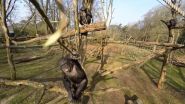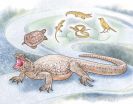Not on my watch: Chimp swats film crew's drone
Incident shows that chimps are able to plan ahead and use tools as weapons
2015-09-03
(Press-News.org) Cool. Calm. And oh, so calculated. That's how a chimpanzee living in the Royal Burgers' Zoo in the Netherlands set out to swat an aerial drone that was filming her group. In an article in the journal Primates published by Springer, Jan van Hooff and Bas Lukkenaar explain it as yet another example of chimpanzees' make-do attitude to using whatever is on hand as tools.
The incident happened earlier this year, on 10 April, when a Dutch television crew was filming at the zoo in Arnhem. The idea was to use a drone to film the chimpanzees in their compound from different close-up angles. The drone already caught the chimpanzees' attention during a practice run. Some grabbed willow twigs off the ground, while four animals took these along when they climbed up scaffolding where the drone was hovering. This behavior is not frequently observed among these chimps.
Filming started when the next drone flew over. It zoomed in on two chimpanzees, the females Tushi and Raimee. They were still seated on the scaffolding holding on to twigs that were about 180 cm (ca. six feet) long. Tushi made two long sweeps with hers - the second was successful in downing the drone and ultimately broke it. Before and during the strike, she grimaced. Although her face was tense and her teeth were bared, she showed no signs of fear. This suggests that she quite deliberately and forcefully struck at the drone, rather than fearfully or reflexively.
"The use of the stick as a weapon in this context was a unique action," comments van Hooff. "It seemed deliberate, given the decision to collect it and carry it to a place where the drone might be attacked."
"This episode adds to the indications that chimpanzees engage in forward planning of tool-use acts," Lukkenaar says, explaining the broader significance of the filmed event. This incident also shows the apes cautiously inspecting the contraption and even throwing it around before they lose interest in it.
According to van Hooff and Lukkenaar, the chimpanzees housed at the Royal Burgers Zoo have never explicitly been taught how to use different tools, but have had ample chance to watch humans handle all kinds of implements. Previous studies showed that the chimps at this Dutch zoo spontaneously and innovatively use up to 13 types of tools in a variety of ways, especially utilizing sticks of different sizes. The apes appear to choose the size, shape and weight of the tools with a particular use in mind. Sticks are, for instance, used to gather fresh leaves from overhead branches, while heavy pieces of wood and stones are chosen as throwing weapons.
INFORMATION:
References:
1. Van Hooff, J.A.R.A.M. & Lukkenaar, B. (2015). Captive chimpanzee takes down a drone: tool use toward a flying object, Primates. DOI 10.1007/s10329-015-0482-2
2. Primates is the official journal of the Japan Monkey Centre.
3. The article has been made freely available online for everyone under the Springer Open Choice program.
[Attachments] See images for this press release:

ELSE PRESS RELEASES FROM THIS DATE:
2015-09-03
Amsterdam, September 3, 2015 - 3D imaging of a mummified kestrel that died due to forced overeating provides evidence that the ancient Egyptians bred birds of prey as offerings for the gods, according to a new study published in the Journal of Archaeological Science. The digital CT imaging revealed that the kestrel was force-fed its last meal - a mouse - suggesting it was kept in captivity.
This is the first evidence to point to mass breeding of raptors as offerings to gods. The researchers behind the study, from the American University in Cairo, Stellenbosch University ...
2015-09-03
Amsterdam, September 3, 2015 - Elsevier, a world-leading provider of scientific, technical and medical information products and services, has announced that its Reviewer Recognition platform has launched a new functionality which enables reviewers to list their entire review history, including their reviews for non-Elsevier journals, in one place online. It also allows them to share their Reviewer Page publically - increasing visibility and recognition of their work.
Through the Reviewer Recognition platform, Elsevier reviewers already have access to a personal review ...
2015-09-03
A 260-million-year-old fossil species found in South Africa's Karoo Basin continues to provide information into the murky origins of turtles whose evolution fascinates scientists.
The fossil of an extinct reptile, named Eunotosaurus africanus, is the earliest known branch of the turtle tree of life.
"Eunotosaurus is a critical link connecting modern turtles to their evolutionary past," says Dr Gaberiel Bever an Honorary Research Associate at Wits University's Evolutionary Studies Institute (ESI) and scientist at the New York Institute of Technology.
Previous studies ...
2015-09-03
UK fisheries survey logbooks from the 1930s to 1950s have been digitised for the first time, revealing how cod responded to changing temperatures in the last century.
Scientists at the Centre for Environment, Fisheries and Aquaculture Science (Cefas) and the University of Exeter found that at the time, the warm seas experienced around Norway benefitted the cod, similar to the conditions there today.
Most cod eaten by the UK comes from northern seas including the Barents Sea around Norway, because the stocks there at the moment are at record highs. Cod stocks were also ...
2015-09-03
Study examines trees in Leicester City
Pollution levels for pedestrians reduced by seven per cent in city environment
Highlights importance of trees in urban planning decisions
Trees in cities throughout the UK could be significantly improving the quality of the air we breathe by decreasing pollution levels for pedestrians, researchers from the University of Leicester have revealed.
The team from the University of Leicester's Department of Physics and Astronomy found that trees have a regionally beneficial impact by increasing turbulence and reducing ambient ...
2015-09-03
In the first study of its kind, new research from the University of New Hampshire shows that crop rotations, in isolation from other management factors, can increase the functions performed by soil microbial communities that benefit plant growth. The study was conducted by researchers with the New Hampshire Agricultural Experiment Station.
The study was conducted by Lisa Tiemann, former postdoctoral student, Stuart Grandy, who was Tiemann's postdoctoral advisor, and Marshall McDaniel, former postdoctoral student of Grandy, all of the UNH Department of Natural Resources ...
2015-09-03
Philadelphia, PA, September 3, 2015 - People diagnosed with schizophrenia critically rely upon treatment with antipsychotic medications to manage their symptoms and help them function at home and in the workplace.
But despite their benefits, antipsychotic medications might also have some negative effects on brain structure or function when taken for long periods of time.
In fact, "the role played by antipsychotic treatment on the pathophysiologic trajectory of brain abnormalities in schizophrenia is currently a matter of lively debate," explains Dr. Antonio Vita, Professor ...
2015-09-03
CAMBRIDGE, Mass.--Researchers at MIT have developed a family of materials that can emit light of precisely controlled colors -- even pure white light -- and whose output can be tuned to respond to a wide variety of external conditions. The materials could find a variety of uses in detecting chemical and biological compounds, or mechanical and thermal conditions.
The material, a metallic polymer gel made using rare-earth elements, is described in a paper in the Journal of the American Chemical Society by assistant professor of materials science and engineering Niels Holten-Andersen, ...
2015-09-03
A sophisticated imaging technique has allowed scientists to virtually peer inside a 10-million-year-old sea urchin, uncovering a treasure trove of hidden fossils.
The international team of researchers from the United Kingdom, Spain and Germany, including Dr Imran Rahman from the University of Bristol, studied the exceptional specimen with the aid of state-of-the-art X-ray computed tomography (CT).
Their results show that the sea urchin fossil was riddled with borings made by shelled invertebrates called bivalves.
These fossilized boring bivalves were preserved inside ...
2015-09-03
WASHINGTON, DC (September 3, 2015)-- The District of Columbia's needle exchange program prevented 120 new cases of HIV infection and saved an estimated $44 million over just a two-year period, according to a first-of-a-kind study published today by researchers at the Milken Institute School of Public Health (Milken Institute SPH) at the George Washington University.
"Our study adds to the evidence that needle exchange programs not only work but are cost-effective investments in the battle against HIV," says Monica S. Ruiz, PhD, MPH, an assistant research professor in ...
LAST 30 PRESS RELEASES:
[Press-News.org] Not on my watch: Chimp swats film crew's drone
Incident shows that chimps are able to plan ahead and use tools as weapons



